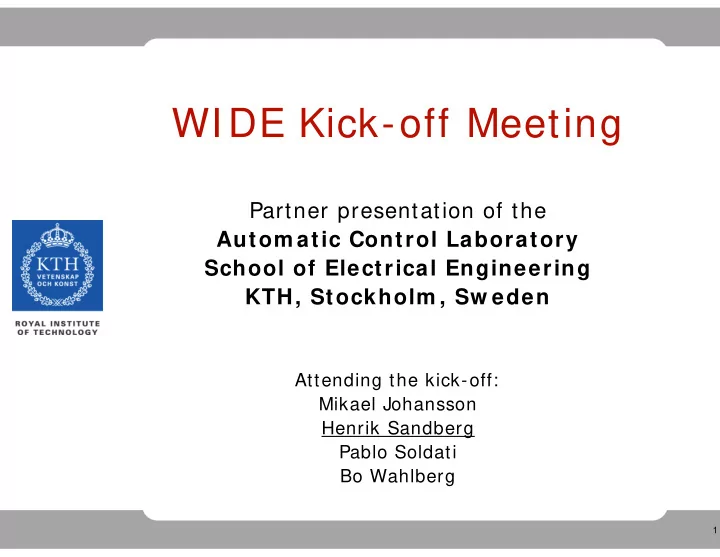

WIDE Kick-off Meeting Partner presentation of the Autom atic Control Laboratory School of Electrical Engineering KTH, Stockholm , Sw eden Attending the kick-off: Mikael Johansson Henrik Sandberg Pablo Soldati Bo Wahlberg 1
Outline • About KTH • About the Automatic Control Lab • Contributions to WIDE - Distributed optimization - Wireless sensor networks - System identification - Model reduction 2
Welcome to KTH KTH, the Royal Institute of Technology Excellence in Education, Research and Entrepreneurship 3
KTH in Stockholm KTH w as founded in 1827 and has remained the largest of Sweden’s technical universities. Since 1917, activities have been housed in central Stockholm in beautiful buildings which are currently protected as being of special historical interest. Associated colleges are found at various places in the Stockholm surroundings – Haninge, Södertälje, and Kista. KTH co-operates w ith Stockholm University in Kista, the main Swedish resource centre of information technology, and in the AlbaNova Centre, with its departments of physics and biotechnology. 4
Students 2007 • A total of approximately 17,000 programme students • 338 KTH students travelling to other universities • 1,057 foreign exchange students began their studies at KTH • 1,105 international master’s students began their studies at KTH • 1,434 active postgraduate students with a minimum of 50% activity 5
Research 2007 NUMBERS OF PROFESSORS 259 professors 5 part-time consulting professors 202 associate professors I NTERNATI ONALLY PUBLI SHED MATERI ALS 1,800 conference contributions (papers, etc.) GROW TH AREAS I N FOCUS Biotechnology Material Science and Engineering Information Technology Energy and Environment 6
Schools From January 2005 School of Architecture and the Built Environm ent School of Biotechnology School of Com puter Science and Com m unication School of Electrical Engineering School of I ndustrial Engineering and Managem ent School of I nform ation and Com m unication Technology School of Chem ical Science and Engineering School of Engineering Sciences School of Technology and Health Scientific I nform ation and Learning KTH Business Liaison 7
Automatic Control Lab • Belongs to School of Electrical Engineering • 4 professors • 1 associate professor • 2 assistant professors • 5 postdocs • 16 Ph.D. students • ~ 10 persons involved in WIDE • Main areas of research Networked Embedded Systems Modeling and Estimation Systems Biology 8
Distributed optimization Researchers: Björn Johansson, Mikael Johansson Research focus: Large-scale optimization, decomposition techniques Novel algorithms for distributed optimization Applications in networking, wireless systems and control 9
Sample application “Distributed m odel-predictive consensus” Agents should distributively agree on optimal “meeting point” Each agent subject to linear dynamics and constraints 10
A prototypical problem Each computational node associated with a cost function f i , and local variables x i Can communicate with subset of “neighboring” nodes Need to distributively agree on optimal global variables θ 11
Results and research Theory: New incremental subgradient methods based on peer-to-peer communication only Novel combinations of subgradient and consensus algorithms Evaluation: Detailed simulations (ns2) + real WSN implementation (ongoing) 12
Wireless sensor networks Researchers: Henrik Sandberg, Pablo Soldati, Haibo Zhang, Mikael Johansson Research focus: Link scheduling and routing for wireless HART Energy efficient networking Control algorithms adapted to WSNs 13
Test bed and test cases Internal test bed at KTH, industrial test case at Boliden (with ABB) 14
Sample problems Scheduling for w ireless HART netw orks Scheduling of deadline-constrained traffic Data evacuation on trees and graphs Graph (routing) for increased resiliency Control algorithms for wHART networks Link scheduling to evacuate data in minimal time, using minimum no. channels 15
System identification Researchers: Märta Barenthin, Mathias Barkhagen, Cristian Rojas, Bo W ahlberg, Håkan Hjalm arsson Visitors 2 0 0 8 -2 0 0 9 : Roland Hildebrand (Université Joseph Fourier, Grenoble) Alireza Karimi (EPFL) Xavier Bombois (TU Delft) Research focus: Orthonormal basis functions (Laguerre, Kautz) Subspace identification Nonlinear systems Identification for control Experiment design Model accuracy 16
Results and research W hat do w e bring to W I DE? 1 ) Analysis tools for m odel accuracy and experim ent design Geometric view Brings the subspace spanned by the predictor gradient into focus Can be used to analyze structural properties, e.g. what happens when a new input or new output is added to the system? Potential for WIDE: Analysis of identification in decentralized systems. Which network structures are good and which are bad, from an identification point of view? 17
18 Sample problem: Cascade (serial) system
Results and research 2 ) How to cope w ith the ”curse of dim ensionality” Common belief: Complex systems = Difficult system id. problems Key insight: ”Clever” excitation can - make important properties visible in data and easy to estimate, but also - hide irrelevant properties so that these do not have to be identified. Embodied in optimal experiment design Example: Use a constant input to estimate the static gain. Works for any LTI system! 19
Results and research 3 ) Experience from identification for control The application governs the properties of interest Optimal experiment design [ c.f. 1)+ 2) above] Challenge: Do the modeling requirements for MPC differ from ”traditional” control? Earlier study w ith ABB Subspace system identification Merging of submodels using structure Model reduction to simplify the resulting model to be used for optimization 20
Model reduction Researchers: 1 Ph.D. student ( to be recruited) , Bo W ahlberg, Henrik Sandberg Visitors during 2 0 0 8 -2 0 0 9 : Michael Cantoni (Univ. of Melbourne) Alexander Lanzon (Univ. of Manchester) Research focus: Structure constraints, networked models, LMIs Model reduction for system identification Time-varying and stochastic systems 21
22 “Norm al” m odel o reduction Sample problem o x Structured m odel reduction
Results and research Theory Linear Fractional Transforms (LFTs) for modeling of networked systems Structured Hankel singular values σ k,i Global error bounds to determine … sufficient submodel complexity Evaluation Reduce order of distributed controllers and plants (ongoing) Quantify importance of links in models (ongoing) Large-scale models needed! 23
Recommend
More recommend